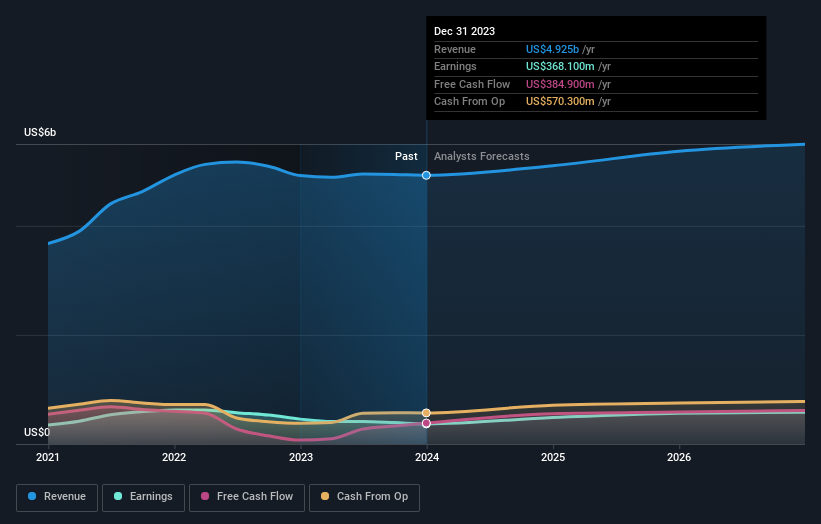Tempur Sealy International, Inc. Just Missed Earnings - But Analysts Have Updated Their Models
Tempur Sealy International, Inc. (NYSE:TPX) last week reported its latest yearly results, which makes it a good time for investors to dive in and see if the business is performing in line with expectations. Revenues of US$4.9b were in line with forecasts, although statutory earnings per share (EPS) came in below expectations at US$2.08, missing estimates by 7.1%. This is an important time for investors, as they can track a company's performance in its report, look at what experts are forecasting for next year, and see if there has been any change to expectations for the business. We thought readers would find it interesting to see the analysts latest (statutory) post-earnings forecasts for next year.
Check out our latest analysis for Tempur Sealy International
Following the latest results, Tempur Sealy International's ten analysts are now forecasting revenues of US$5.10b in 2024. This would be an okay 3.6% improvement in revenue compared to the last 12 months. Statutory earnings per share are predicted to leap 27% to US$2.72. In the lead-up to this report, the analysts had been modelling revenues of US$5.09b and earnings per share (EPS) of US$2.80 in 2024. The analysts seem to have become a little more negative on the business after the latest results, given the small dip in their earnings per share numbers for next year.
Despite cutting their earnings forecasts,the analysts have lifted their price target 7.5% to US$59.88, suggesting that these impacts are not expected to weigh on the stock's value in the long term. It could also be instructive to look at the range of analyst estimates, to evaluate how different the outlier opinions are from the mean. Currently, the most bullish analyst values Tempur Sealy International at US$65.00 per share, while the most bearish prices it at US$50.00. With such a narrow range of valuations, the analysts apparently share similar views on what they think the business is worth.
These estimates are interesting, but it can be useful to paint some more broad strokes when seeing how forecasts compare, both to the Tempur Sealy International's past performance and to peers in the same industry. It's pretty clear that there is an expectation that Tempur Sealy International's revenue growth will slow down substantially, with revenues to the end of 2024 expected to display 3.6% growth on an annualised basis. This is compared to a historical growth rate of 14% over the past five years. Compare this against other companies (with analyst forecasts) in the industry, which are in aggregate expected to see revenue growth of 4.7% annually. Factoring in the forecast slowdown in growth, it seems obvious that Tempur Sealy International is also expected to grow slower than other industry participants.
The Bottom Line
The biggest concern is that the analysts reduced their earnings per share estimates, suggesting business headwinds could lay ahead for Tempur Sealy International. On the plus side, there were no major changes to revenue estimates; although forecasts imply they will perform worse than the wider industry. We note an upgrade to the price target, suggesting that the analysts believes the intrinsic value of the business is likely to improve over time.
Keeping that in mind, we still think that the longer term trajectory of the business is much more important for investors to consider. We have estimates - from multiple Tempur Sealy International analysts - going out to 2026, and you can see them free on our platform here.
However, before you get too enthused, we've discovered 1 warning sign for Tempur Sealy International that you should be aware of.
Have feedback on this article? Concerned about the content? Get in touch with us directly. Alternatively, email editorial-team (at) simplywallst.com.
This article by Simply Wall St is general in nature. We provide commentary based on historical data and analyst forecasts only using an unbiased methodology and our articles are not intended to be financial advice. It does not constitute a recommendation to buy or sell any stock, and does not take account of your objectives, or your financial situation. We aim to bring you long-term focused analysis driven by fundamental data. Note that our analysis may not factor in the latest price-sensitive company announcements or qualitative material. Simply Wall St has no position in any stocks mentioned.

